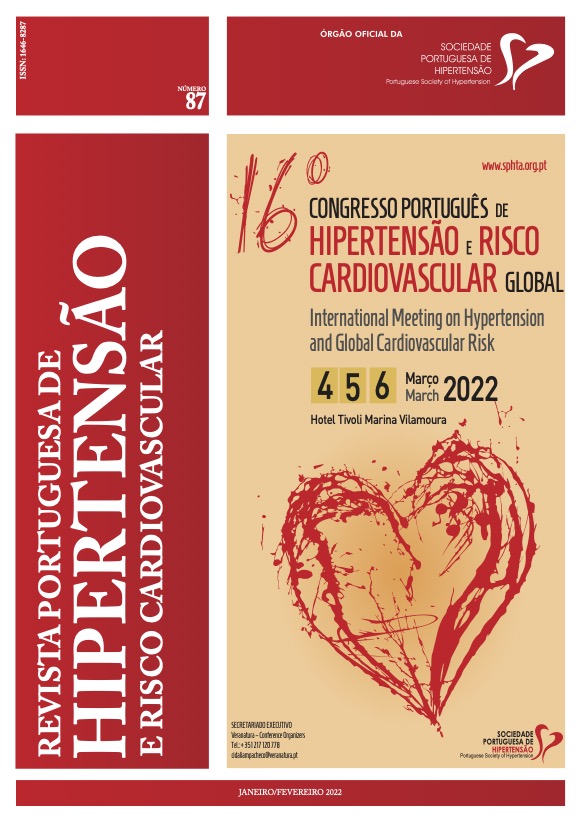THE CARDIOVASCULAR RISK IN FAMILY PLANNING COUNSELLING
DOI:
https://doi.org/10.58043/rphrc.5Keywords:
Obesity, Family Planning, HypertensionAbstract
Introduction: It is important to acknowledge, in a medical appointment, when a new and unexpected clinical problem arises and needs a holistic approach. This clinical case aims, on one hand, to reinforce that Family Medicine distinguishes itself from other medical specialties by the continuity of care that allows a holistic approach of the patient, not isolating one pathology or risk factor from the patient’s remaining clinical history; on the other hand, recall that all medical specialties must bear in mind that these risks are not independent from each other.
Clinical case: A 42 year old woman with past medical history of class I obesity and choriocarcinoma in remission. Medicated with ethinyl estradiol + gestodene, 0.03 mg + 0.075 mg, 1 tablet / day for 21 days with a 7-day break, enies ethanolic, smoking or other habits. At a routine medical appointment, in the physical examination, she weighed 86 kg, and 167 cm tall, a body mass index (BMI) of 30.84 kg / m2 (class I obesity) and an average blood pressure of successive measurements of 150/80 mmHg. The patient was requested to control blood pressure in ambulatory setting and a new appointment was scheduled 2 months later. In the next medical appointment, the patient presented the blood pressure record with systolic blood pressure values greater than 160 mmHg and diastolic blood pressure greater than 90 mmHg, normocardial. In the physical examination, she had an average blood pressure of successive measurements of 180/100 mmHg, with an identical BMI and a low cardiovascular SCORE risk (<1%). The patient was diagnosed with grade 2/3 arterial hypertension (based on both ambulatory and appointment values) and it was decided to prescribe lisinopril + amlodipine 20 mg + 5 mg 1 tablet / breakfast. Complementary diagnostic tests were performed to study the hypertension etiology, that revealed essential hypertension and, due to the increased cardiovascular risk, combined oral contraceptive was substituted by an intrauterine device with levonrgestrel.
Discussion: Although there is evidence that obesity increases drug hepatic metabolism and contraceptive adipose tissue absorption, which results in the need of higher contraceptive doses to reach therapeutic level, there is no indication to adapt contraceptive counseling in healthy obese women. However, if there is hypertension, combined oral contraceptives constitute an absolute contraindication, especially when associated with other risk factors for cardiovascular disease, such as age over 35 years, smoking more than 15 cigarettes a day or dyslipidemia. Considering the patient’s comorbidities, an intrauterine device with levonorgestrel was chosen. This clinical case proves that Family Medicine distinguishes itself from other medical specialties by the continuity of care that allows the patient holistic approach, not isolating a pathology or risk from the patient’s remaining history, thus ensuring interdisciplinary and integrated approach of the patient.
Downloads
References
Mendes Nunes, J. Comunicação em Contexto Clínico. Lisboa: Bayer HealthCare; 2010.
Direção-Geral da Saúde. Hipertensão Arterial: definição e classificação; 2013; [consultado em 2020 dez 19]. Disponível em: https://www.dgs.pt/directrizes-da-dgs/normas-e- circulares-normativas/norma-n-0202011-de-28092011- atualizada-a-19032013-jpg.aspx
Sociedade Portuguesa de Cardiologia. Sociedade Europeia de Cardiologia. Recomendações de Bolso de 2018 da ESC – Comissão para as Recomendações Práticas; 2018; [consultado em 2020 dez 19]. Disponível em: https://spc.pt/wp-content/ uploads/2019/10/Pocket-guidelines-Hipertens%C3%A3o.pdf
Gillum, L. A., Mamidipudi, S. K. & Johnston, S. C. Ischemic stroke risk with oral contraceptives: A meta-analysis. JAMA 284, 72–8 (2000)
WHO. Medical eligibility criteria for contraceptive use. WHO (2015).
Edelman A, Carlson N, Cherala G, Munar M, Stouffer R, Cameron J, et al. Impact of obesity on oral contraceptive pharmacokinetics and hypothalamic-pituitary-ovarian activity. Contraception. 2009; 80(2):119-27. DOI: 10.1016/j. contraception.2009.04.011. Epub 2009 Jun 4.
Edelman A, Cherala G, Munar M, Dubois B, Mclnnis M, Stanczyk F, et al. Prolonged monitoring of ethinyl estradiol and levonorgestrel levels confirms an altered pharmacokinetic profile in obese oral contraceptives users. Contraception. 2013; 87(2):220-6. DOI: 10.1016/j.contraception.2012.10.008. Epub 2012 Nov 12.
Sociedade Portuguesa da Contraceção. Sociedade Portuguesa de Ginecologia. Sociedade Portuguesa de Medicina da Reprodução. Consenso sobre Contraceção 2020; 2020; [consultado 2020 dez 19]. Disponível em: https://www.spdc. pt/images/CONSENSOS_FINAL.pdf
ACOG. Clinical Management Guidelines for Obstetrician – Gynecologists:Use of hormonal contraception in women with coexisting medical conditions. Obstetrics & Gynecology 133, 128–150; 2019.
Costa, A., Bombas, T., Souto, S. & Freitas, P. Recomendações para contraceção em mulheres com excesso de peso/obesidade, antes e após cirurgia bariática. Acta Obstet Ginecol Port 14, 38–43; 2020; [consultado em 2020 dez 31]. http://www.scielo.mec.pt/scielo. php?script=sci_arttext&pid=S1646-58302020000100009
Sociedade Portuguesa de Ginecologia. Consenso Nacional sobre Hemorragias Uterinas Anormais. 50–54; 2018; [consultado em 2020 dez 31]. Disponível em: http://www.spginecologia. pt/uploads/consenso-nacional-sobre-hemorragias-uterinas- anormais.pdf
Downloads
Published
How to Cite
Issue
Section
License
Copyright (c) 2022 Revista Portuguesa de Hipertensão e Risco Cardiovascular

This work is licensed under a Creative Commons Attribution 4.0 International License.




